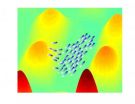(Press-News.org) ITHACA, N.Y. - Like a shadowy character just hidden from view, a mystery atom in the middle of a complex enzyme called nitrogenase had long hindered scientists' ability to study the enzyme fully.
But now an international team of scientists led by Serena DeBeer, Cornell assistant professor of chemistry and chemical biology, has pulled back the curtain using powerful synchrotron spectroscopy and computational modeling to reveal carbon as the once-elusive atom.
The research was published online Nov. 17 in the journal Science.
"For chemists, one of the first steps you want to be able to take is to actually model the site," said DeBeer. "It turns out that the chemistry of how this cluster behaves will be different depending on what atom is in the middle. This is the first step toward trying to unravel its mechanism."
Why nitrogenase? In nature, all life requires the element nitrogen from the atmosphere to form amino acids and build proteins. Bacteria need to convert nitrogen to ammonia as a precursor to more complex biosynthetic processes. The enzyme that catalyzes all this is nitrogenase, and it does it by breaking one of the strongest bonds in chemistry – the nitrogen triple bond.
The chemical industry has figured out how to convert nitrogen to ammonia in high-temperature and high-pressure industrial environments. There's a fascination with understanding how the enzyme makes this same process work in nature, DeBeer said.
DeBeer and colleagues honed in on a subset of atoms in the relatively large enzyme, called the iron-molybdenum cofactor, which was thought to be the site where dinitrogen (N2) gets converted to ammonia, and where the mystery atom is situated inside.
The team used a method called X-ray emission spectroscopy (XES) at the Stanford Synchrotron Radiation Light Source to excite the electrons in the cofactor's iron cluster and to watch how electrons refilled the spots, called "holes," they left behind. The holes were sometimes filled by an electron belonging to a neighboring atom – emitting X-ray signatures with distinct ionization potentials that would distinguish between different kinds of atoms.
This was how it was revealed that the cofactor contained a carbon atom, rather than a nitrogen or an oxygen atom, that was bound to the iron atoms in the cluster.
###
The paper's first author is Kyle M. Lancaster, a Cornell postdoctoral associate in chemistry. DeBeer's collaborators are at the University of Bonn in Germany, University of California-Irvine, Max Planck Institute and the SLAC National Accelerator Laboratory at Stanford.
The research was supported by Cornell, the University of Bonn, the Max Planck Society and the National Institutes of Health.
In an enzyme critical for life, X-ray emission cracks mystery atom
2011-11-21
ELSE PRESS RELEASES FROM THIS DATE:
Environmental conditions and predators affect Atlantic salmon survival in the Gulf of Maine
2011-11-21
Stocks of Atlantic salmon (Salmo salar), which have been steadily declining for the past few decades, are facing new challenges in the Gulf of Maine, where changing spring wind patterns, warming sea surface temperatures and new predators along altered migration routes are affecting their survival.
In a paper published online in the journal Fisheries Management and Ecology, Kevin Friedland and co-authors suggest post-smolts are entering an increasingly warmer coastal ocean, where they are facing mortality risks associated with a changing climate, such as changing distributions ...
Researchers discover new way to form extracellular vesicles
2011-11-21
Researchers at NYU Langone Medical Center have discovered a protein called TAT-5 that affects the production of extracellular vesicles, small sacs of membrane released from the surface of cells, capable of sending signals to other cells. When released extracellular vesicles can affect tumor spread, blood clotting and inflammation. Their discovery gives new insight into how extracellular vesicles form, and reveals new potential strategies to manipulate diseases such as cancer. The study was published online November 17, 2011 in Current Biology.
"Very little is known ...
Micro-cavity arrays: Lighting the way to the future
2011-11-21
It was not too long ago that basic science lectures began with the three forms of matter: gases, liquids and solids—and somewhere along the line plasmas were occasionally added to the list. But to be precise, a plasma is an ionized gas; thus, a subset of the big three. But this subset has coexisted with the other forms since the Big Bang and actually makes up 99 percent of the universe. It is found in our Sun and all the other stars, and in more down to earth applications: in neon signs, Plasma TVs, Cathode Ray Tubes, and the ubiquitous fluorescent light.
It is now ...
Bleak future for Bay area tidal marshes?
2011-11-21
[San Francisco, CA] – A new study, led by PRBO Conservation Science (PRBO), projects a bleak future for San Francisco Bay's tidal marshes under high-end sea-level rise scenarios that are increasingly likely. PRBO and colleagues found that in the worst case scenario 93% of San Francisco Bay's tidal marsh could be lost in the next 50-100 years [with 5.4 feet or 1.65 meters of sea-level rise, low sediment availability and no significant restoration].
PRBO's study indicates, however, that not all marshes will be lost and that society's actions today, including restoration ...
Smart swarms of bacteria inspire robotics researchers
2011-11-21
Much to humans' chagrin, bacteria have superior survival skills. Their decision-making processes and collective behaviors allow them to thrive and even spread efficiently in difficult environments.
Now researchers at Tel Aviv University have developed a computational model that better explains how bacteria move in a swarm — and this model can be applied to man-made technologies, including computers, artificial intelligence, and robotics. Ph.D. student Adi Shklarsh — with her supervisor Prof. Eshel Ben-Jacob of TAU's Sackler School of Physics and Astronomy, Gil Ariel ...
Targeting bacterial gas defenses allow for increased efficacy of numerous antibiotics
2011-11-21
Although scientists have known for centuries that many bacteria produce hydrogen sulfide (H2S) it was thought to be simply a toxic by-product of cellular activity. Now, researchers at NYU School of Medicine have discovered H2S in fact plays a major role in protecting bacteria from the effects of numerous different antibiotics.
In the study led by Evgeny Nudler, PhD, the Julie Wilson Anderson Professor of Biochemistry at NYU School of Medicine, researchers found evidence that H2S acts as a general defense mechanism against oxidative stress, the process through which ...
NASA's Chandra adds to black hole birth announcement
2011-11-21
New details about the birth of a famous black hole that took place millions of years ago have been uncovered, thanks to a team of scientists who used data from NASA's Chandra X-ray Observatory as well as from radio, optical and other X-ray telescopes.
Over three decades ago, Stephen Hawking placed -- and eventually lost – a bet against the existence of a black hole in Cygnus X-1. Today, astronomers are confident the Cygnus X-1 system contains a black hole, and with these latest studies they have remarkably precise values of its mass, spin, and distance from Earth. With ...
VLBA observations key to 'complete description' of black hole
2011-11-21
For the first time, astronomers have produced a complete description of a black hole, a concentration of mass so dense that not even light can escape its powerful gravitational pull. Their precise measurements have allowed them to reconstruct the history of the object from its birth some six million years ago.
Using several telescopes, both ground-based and in orbit, the scientists unravelled longstanding mysteries about the object called Cygnus X-1, a famous binary-star system discovered to be strongly emitting X-rays nearly a half-century ago. The system consists of ...
Study of flower petals shows evolution at the cellular level
2011-11-21
A new study of flower petals shows evolution in action, and contradicts more that 60 years of scientific thought.
The findings are reported by a scientist from UC Santa Barbara and a research team from Harvard University in the Proceedings of the Royal Society B this week.
Columbine flowers, known as Aquilegia, evolved several lengths of petal spurs that match the tongue lengths of their pollinators, including bees, hummingbirds, and hawkmoths. The petal spurs are shaped like a tubular pocket and contain nectar at the tip. The spurs grow from 1 to 16 centimeters in ...
Molecules on branched-polymer surfaces can capture rare tumor cells in blood
2011-11-21
The removal of rare tumor cells circulating in the blood might be possible with the use of biomolecules bound to dendrimers, highly branched synthetic polymers, which could efficiently sift and capture the diseased cells, according to new research at the University of Illinois at Chicago.
Dendrimers have been used to encapsulate drug molecules and serve as a delivery vehicle, but in the new study they were employed to capture circulating tumor cells by biomimicry -- using nanotechnology to create artificial surfaces much like those in real cells.
"We want to take advantage ...



